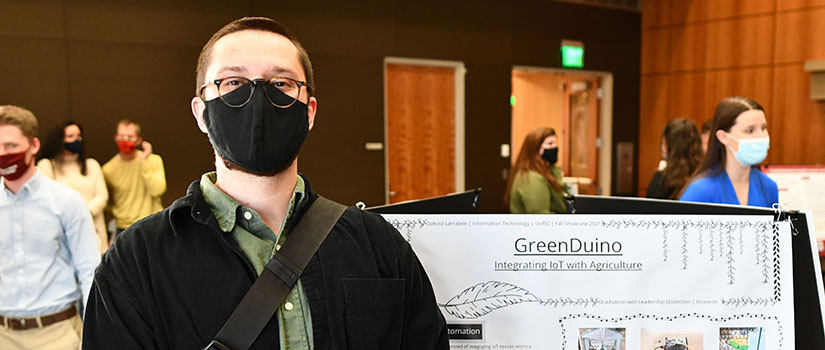Combining technology with common, everyday objects is the basis of the Internet of Things (IoT) but utilizing it for agriculture is a recent development. Integrated Information Technology (IIT) senior Dakota Larrabee has been working to determine how IoT can simplify growing produce for not only farmers but also for gardening and greenhouse enthusiasts. His project has earned him Graduation with Leadership Distinction when he completes his degree in December.
Larrabee’s research focuses on integrating IoT devices with greenhouse or agricultural automation, a process known as smart farming. Starting his research this past April, his goal was to develop an automatic watering concept for a garden or farm. Larrabee’s idea came from his own experiences of forgetting to water his own garden. He thought he could overcome his lack of a green thumb through automation.
“I concluded that people either don’t have the time to garden or they believe it’s too difficult. My idea was combining gardening and these IoT devices to automate some of the more repetitive tasks, such as watering,” Larrabee says. “I wanted to do this research in the name of self-sustainability and to be able to grow my own produce with a completely automated system.”
Larrabee’s idea started with a small, four-tier greenhouse. The first automated water pump was intended to be with sprinkler heads, but the water pressure was too weak and would cause too many negative impacts to the electronics. So, he designed stronger water pumps consisting of soaker hoses placed underneath the soil to water the plants at their roots. The automated system was a ladder-type design utilizing a system of soaker hoses attached to PVC pipes next to each soil pan. He then conducted another test by filling one of the pans with soil to see how efficiently the design could fill the pans with water and how quickly it would take to moisten the soil.
“We changed the design because not only was it something we could control a little easier, but it would water the plants more effectively,” Larrabee says. “After securing the joints, it worked perfectly.”
Larrabee then used an IoT enabled microcontroller to house the electronics. The microcontroller relays and receives information, while an ENV (environmental) shield’s embedded sensors monitors and measures conditions, including humidity, temperature and pressure. Live updates of sensor values and data are relayed to an IoT Cloud dashboard. Line graphs of some of the sensor data is also displayed to demonstrate change over a specific time. Larrabee added another external sensor for measuring soil moisture of the greenhouse that could be adjusted based on data collected by the microcontroller.
I have been impressed by Dakota's initiative and technical competence in applying Internet of Things technology to greenhouse conditions. This is an emerging industry, and his creativity and ingenuity contribute to a body of knowledge that will change farming in South Carolina.
-Sharon Gumina, Integrated Information Technology Instructor
“The monitoring of my greenhouse’s environment allows me to make informed decisions based on sensory data. I can better keep the environment suitable for the plant’s needs,” Larrabee says.
The water is automated to the greenhouse through power manipulation. Larrabee built a smart outlet, which is connected to the IoT device by jumper wires and includes a relay switch to receive the instructions from the device. Data is generated from the soil moisture sensor, and the IoT device interprets the specific value. Based on the data, the relay switch receives instructions on whether to turn on the water, which is powered by the smart outlet. Larrabee used this process for successfully growing red Russian kale microgreens.
“The principles of sensor actuation and power manipulation turn on the watering pump and water the plants by utilizing the data captured by the IoT device. I shut off the water pump by leveraging the same data received from the soil moisture sensor,” Larrabee says. “The code uploaded to the IoT device is written so that when a certain level of soil moisture is met, it tells the relay switch to break the connection and stop powering the outlet. This shuts off the water pump, and the plants are automatically watered to a level I wrote in the code.”
Larrabee’s smart farming research and possible solutions have already been implemented through irrigation at a greenhouse located on a local farm owned by IIT Professor Neset Hikmet. Larrabee usually visits the farm weekly.
“I hope to install pH sensors and additional moisture sensors,” Larrabee says. “I eventually plan on taking the same principles in what I’m doing at Dr. Hikmet's farm for my own beds in my backyard.”
Larrabee believes that smart farming could eventually become mainstream in the U.S. He also feels that developing an automated water system has brought him closer to his goal of self-sufficiency.
“I would love to design a kit that anyone could purchase with instructions to automate their own greenhouse environment,” Larrabee says. “I hope to continue my research and utilize IoT devices to make other smart devices that can help farms, livestock and larger greenhouses. The idea of automating a greenhouse may not have been something I thought of when I first heard of IoT devices in ITEC 101 but knowing they exist has helped me in my research.”
